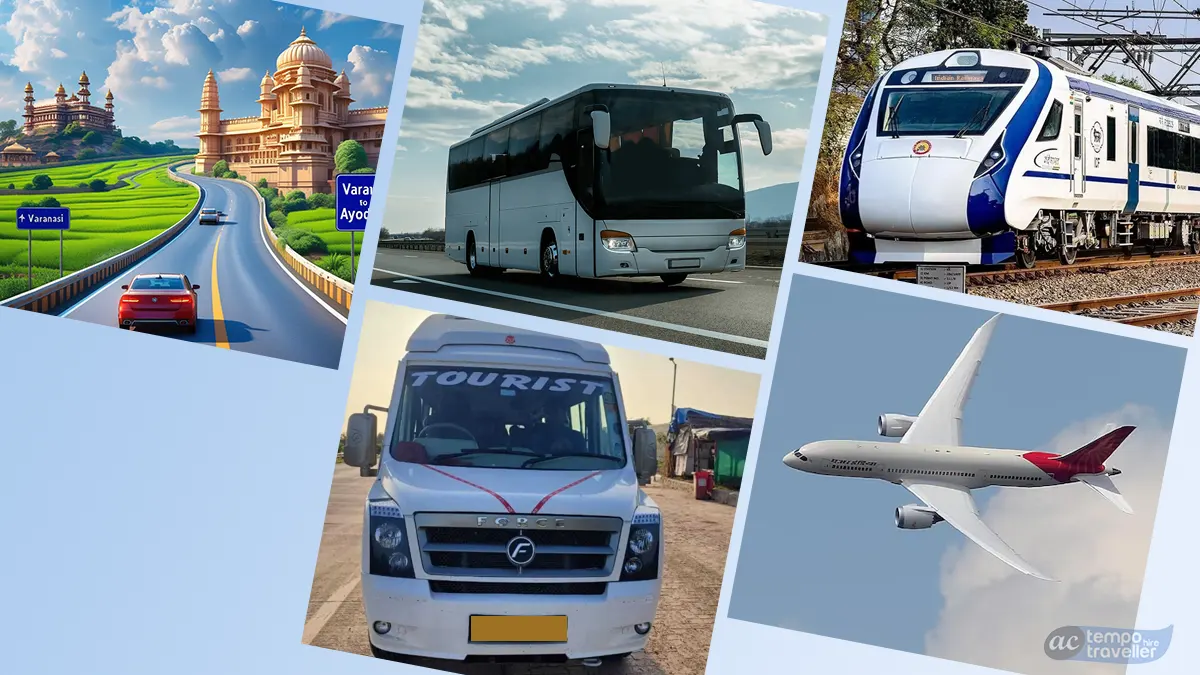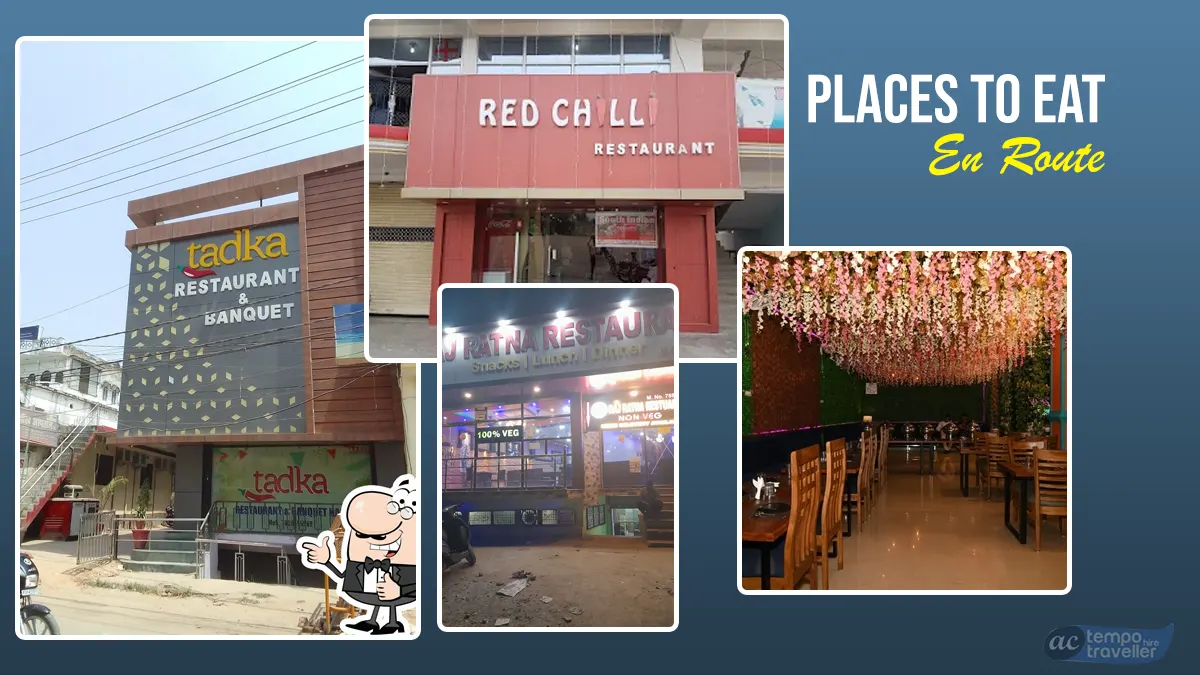Varanasi to Ayodhya Road Trip
What if you could travel between two of India's most sacred cities in just a few hours and experience 3,000 years of history, the country's vibrant culture and some of its most breathtaking landscapes along the way? That's the promise of a journey between Varanasi and Ayodhya. Varanasi or Kashi, as locals call it, is one of the oldest continuously inhabited cities on the planet.
Ayodhya, meanwhile, is the city where Lord Rama was born, according to ancient scriptures like the Ramayana, and where history stretches back over 9,000 years. But how long does that actually take? What's the best route? Are the roads up to the task? Those are the questions every traveller asks before planning a Varanasi to Ayodhya road Trip. The roads between the two cities are a mix of highways and rural landscapes, you can choose your route based on what you prefer most.
Quick Facts About Varanasi to Ayodhya Road Trip
- Total Distance: 219 to 232 km depending on the route.
- Travel Time: 4 to 5 hours by road.
- Best Route: NH 731 and NH 330 for a smooth drive.
- Alternative Routes: Purvanchal Expressway and NH 135A.
- Best Travel Season: October to March.
- Popular Stops: Jaunpur, Sultanpur, Dostpur Wildlife Sanctuary.
What is the Distance Between Varanasi and Ayodhya?
The distance between Varanasi and Ayodhya depends on the route you take. The shortest route via NH 731 and NH 330 is 219 km and is the most popular as the roads are well maintained. The other option is via the Purvanchal Expressway which is 232 km with high speed road. The third option via NH 135A is 230 km and goes through rural areas. Actual distance may vary depending on diversions, bypasses and local roads within city limits. Please check the GPS for real time distance. Those who take highways will have a faster journey and those who prefer countryside routes will have a peaceful drive.
Travel Time from Varanasi to Ayodhya
Road conditions, traffic and the mode of transport you choose, all determine how long it takes to get from Varanasi to Ayodhya. If you are travelling by car then the quickest route is via NH 330 and NH 731 and it takes around 4 to 5 hours. The Purvanchal Expressway route is smoother, but actually adds a bit more distance. That puts the total travel time at around 5 hours. Variable road conditions can also make the NH 135A route take up to 5 hours. Trains are generally faster and takes around 3.5 to 4 hours. Buses, on the other hand can take anywhere from 5 to 6 hours but it depends on the type of bus and how many stops it makes along the way.
What is the Best Time to Visit Ayodhya?
The best time to visit Ayodhya is between October and March. That is when the weather is just right for sightseeing. Temperatures from April to June can soar above 40°C, making daytime travel pretty tough. Monsoon months, July to September, bring unpredictable rains that can cause delays on some routes. If you are planning to visit during major festivals like Diwali or Ram Navami you should book your accommodations well in advance. Winter months are ideal for temple visits, local tours and exploring markets without the extreme weather. A quick check of the forecast before you travel will give you a pleasant experience and avoid any unexpected weather disruptions.
All Routes from Varanasi to Ayodhya
Route 1. NH 731 and NH 330 route (219 km, 4 to 5 hours)
This is the most popular choice for travellers due to its well maintained roads and direct connectivity. You will pass through Jaunpur and Sultanpur, where you can easily find fuel stations also roadside eateries. That steady driving experience with fewer traffic stops is a big plus. Many groups travelling through this route prefer to Hire a Tempo Traveller in Varanasi.
Route 2. Purvanchal Expressway (232 km, 5 hours)
This is where you will find modern infrastructure and smooth roads. You can drive at high speed without interruptions but do keep an eye out for those connecting roads that might have patchy conditions. If you prefer expressways over highways then this is a good option. Just be aware that there are limited rest stops so plan your fuel and food breaks before you get on the expressway.
Route 2. NH 135A (230 km, 5 hours)
This is a more rural route with less traffic, which can make for a peaceful drive. You will find local eateries and roadside stalls in the small villages along the way to grab a bite. This route is ideal for those who prefer less crowded roads. Travelling during the day is a good idea because of the lack of streetlights.
What Are the Best Ways to Travel from Varanasi to Ayodhya?

By Car
Travel by car on rent gives you the freedom to stop whenever you feel like it. Whether at a roadside restaurant or a tourist spot along the way. That 4 to 5 hour journey can be quite a bit more enjoyable with those breaks. Families or small groups often prefer private taxis or self-driven vehicles for that added comfort and security.
By Tempo Traveller
These vehicles come with comfortable seating, air conditioning and plenty of space for luggage. That makes them a budget-friendly option compared to hiring multiple cars or taxis. You can book your Tempo Traveller with a chauffeur service. It is a good idea to do that in advance, especially during peak seasons or festival times. Renting a Tempo Traveller in Ayodhya is a great choice for larger groups for local sightseeing.
By Bus
Buses run regularly between Varanasi and Ayodhya. You can expect the journey to take anywhere from 5 to 6 hours. Both air conditioned and non-air conditioned buses are available to suit different budgets. If you prefer to travel at night then overnight buses are an option that will get you to Ayodhya in the morning. Booking online gives you a better chance at getting the seat you want.
By Train
Trains are the fastest and most budget-friendly way to get to Ayodhya. The Jammu Tawi Express (13151) takes 3.5 hours, the Ganga Sutlej Express (13307) takes 4 hours. Because demand is so high, it's a good idea to book your tickets in advance. You can choose from sleeper, AC chair car and general compartments.
By Flight
There are no direct flights available from Varanasi to Ayodhya. The flight takes 14-15 hours to complete this journey and costs around INR 10,000 to INR 12,000. So for this short distance travel flight is not the appropriate option. If you are reaching Ayodhya from any other city then Airport cabs and pre-booked taxis are available at Ayodhya Airport for onward travel.
Read More: Complete Guide to Visit Khatu Shyam
Popular Places to Visit En Route
Jaunpur
Jaunpur is called the "City of the Sultans" and is a town that speaks of the Mughal and Shahi era. It has the beautiful Atala Mosque which is a masterpiece of Indo-Islamic architecture. The Shahi Bridge on the river Gomti is another landmark here. The town is famous for its unique handicrafts, especially Jaunpur sarees which are embroidered with zari work.
Badlapur
Badlapur is a peaceful village situated on the banks of the Saraswati River. If you want to experience the rural Uttar Pradesh, then stop here. The village has a few temples which add to its spiritual ambiance. Travellers can also taste local cuisine in the small eateries on the way.
Sultanpur
Sultanpur is famous for its Sultanpur Bird Sanctuary which attracts birdwatchers from all over the world. The sanctuary has over 250 species of migratory birds during the winter season. The nearby Kurebhar Dam is a place where you can relax amidst greenery by the calm waters.
Dostpur Wildlife Sanctuary
Dostpur Wildlife Sanctuary is an untouched gem on the Varanasi-Ayodhya route. This green forest reserve is home to various wildlife species like leopards, jackals and deer. It’s a perfect spot for bird watching and wildlife photography.
Places to Eat En Route

Tadka Restaurant & Banquet, Jaunupur This eatery is well known for its cosy seating and North Indian cuisine. The food is of great quality and the service is prompt.
Red Chilli Restaurant, Jaunpur A well liked destination for tourists, this eatery offers both vegetarian and non vegetarian options. The atmosphere is suitable for families.
Raj Ratan Restaurant, Faizabad The Raj Ratan Restaurant which is close to Ayodhya, serves a combination of modern and traditional cuisine. It's a nice spot to have a leisurely meal before heading to your destination.
Sundae Restaurant, Sultanpur The clean food and welcoming staff of Sundae Restaurant are well known. With a menu that combines Chinese and Indian food, it's a fantastic destination for tourists seeking diversity.
Most Famous Places to Visit in Ayodhya
Ram Janmabhoomi Temple
Ram Janmabhoomi is where Lord Rama was born. It’s the most important pilgrimage in Ayodhya and thousands of devotees visit daily. The temple has been renovated recently and it’s a grand experience.
Hanuman Garhi
Dedicated to Hanuman, this temple is on a hill and you have to climb a little. Devotees believe that visiting this temple fulfills wishes and gives protection. The view from the top is worth the climb.
Kanak Bhawan
Kanak Bhawan is a temple of Lord Rama and Goddess Sita. The idols inside the temple are decorated with gold ornaments.
Nageshwarnath Temple
This temple is of Lord Shiva and one of the oldest in Ayodhya. It’s believed to be established by Kush, son of Lord Rama. It sees the heavy rush of pilgrims during Shivratri.
Guptar Ghat
Located on the banks of the Sarayu River, Guptar Ghat is very spiritual. It’s believed that Lord Rama took his last journey from this ghat. The surroundings are very calm and it’s a great place for meditation and relaxation.
Popular Places to Visit Nearby Ayodhya
If you have time to spare, there are many places to see near Ayodhya.
Faizabad is just a few kilometers away and is famous for its Nawabi heritage and Mughal architecture. Gulab Bari and Bahu Begum ka Maqbara are two historical places to visit to know more about the region. Makhaura Dham is a temple dedicated to King Dasharatha, 40 km from Ayodhya.
Chitrakoot is 130 km away and is another important pilgrimage site of Lord Rama’s exile. The place is full of temples and scenic beauty. Travelers who love cultural and spiritual experiences include Chitrakoot in their itinerary.
Lucknow, the capital of UP is 135 km from Ayodhya and has heritage, food and shopping. You can visit Bara Imambara, Rumi Darwaza and Hazratganj market for a complete experience.

